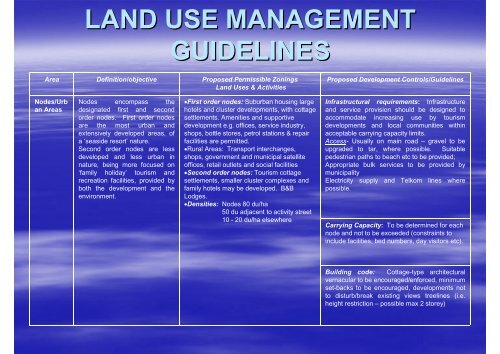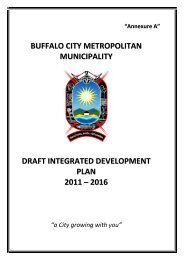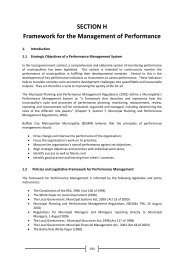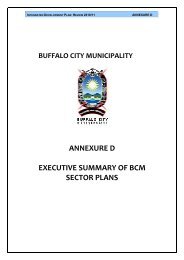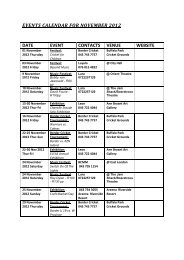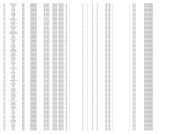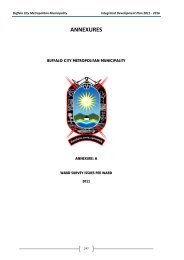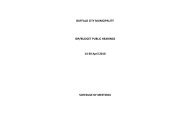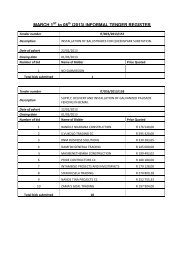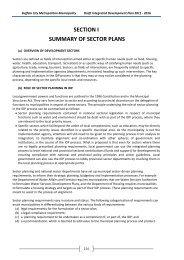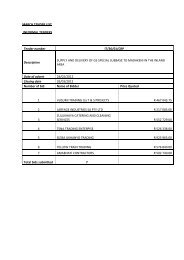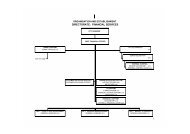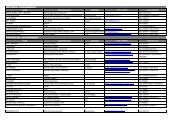LAND USE MANAGEMENT GUIDELINES - Buffalo City
LAND USE MANAGEMENT GUIDELINES - Buffalo City
LAND USE MANAGEMENT GUIDELINES - Buffalo City
- No tags were found...
You also want an ePaper? Increase the reach of your titles
YUMPU automatically turns print PDFs into web optimized ePapers that Google loves.
<strong>LAND</strong> <strong>USE</strong> <strong>MANAGEMENT</strong><strong>GUIDELINES</strong>AreaDefinition/objectiveProposed Permissible ZoningsLand Uses & ActivitiesProposed Development Controls/GuidelinesNodes/Urban AreasNodes encompass thedesignated first and secondorder nodes. First order nodesare the most urban andextensively developed areas, ofa ‘seaside resort’ nature.Second order nodes are lessdeveloped and less urban innature, being more focused on‘family holiday’ tourism andrecreation facilities, provided byboth the development and theenvironment.First order nodes: Suburban housing largehotels and cluster developments, with cottagesettlements. Amenities and supportivedevelopment e.g. offices, service industry,shops, bottle stores, petrol stations & repairfacilities are permitted.Rural Areas: Transport interchanges,shops, government and municipal satelliteoffices, retail outlets and social facilitiesSecond order nodes: Tourism cottagesettlements, smaller cluster complexes andfamily hotels may be developed. B&BLodges.Densities: Nodes 80 du/ha50 du adjacent to activity street10 - 20 du/ha elsewhereInfrastructural requirements: Infrastructureand service provision should be designed toaccommodate increasing use by tourismdevelopments and local communities withinacceptable carrying capacity limits.Access- Usually on main road – gravel to beupgraded to tar, where possible. Suitablepedestrian paths to beach etc to be provided;Appropriate bulk services to be provided bymunicipalityElectricity supply and Telkom lines wherepossible.Carrying Capacity: To be determined for eachnode and not to be exceeded (constraints toinclude facilities, bed numbers, day visitors etc).Building code: Cottage-type architecturalvernacular to be encouraged/enforced, minimumset-backs to be encouraged, developments notto disturb/break existing views treelines (i.e.height restriction – possible max 2 storey)
<strong>LAND</strong> <strong>USE</strong> <strong>MANAGEMENT</strong><strong>GUIDELINES</strong>AreaDefinition/objectiveProposed Permissible ZoningsLand Uses & ActivitiesProposed Development Controls/Guidelines“LimitedDevelopment” AreasAreas which fall within the “limiteddevelopment” category, but notwithin the No Development Zoneare areas where there can only below intensity, environmentally andculturally sensitive development.Development should protect andpromote environmental, culturaland landscape integrity.Land use in this zone must becompatible with the relevantprovisions of Coastal ZoneManagement Policy and theprovisions of the Land UseManagement Guidelines. Thesezones should act as a buffer zonebetween the nodes andConservation Areas.Residential 2 Zone at a density of: 2du/ha (excluding hotels).Limited and regulated tourismactivities.Small accommodation facilities thatare low-key, low-impact and inharmony with the natural environment.Agricultural activities.Land uses other than eco-tourismfacilities and residential use (such asschools and retail offices) to bediscouraged.Full IEM procedures to precede anydevelopment.Controlled low density residentialhousing development.Building footprint 200 m².Subdivision : Maximum size – 1500m².Infrastructural requirements: Access along existingroads into areas, No roads parallel to the beach.Suitable service infrastructure to cater for eco-tourismdevelopments.Carrying Capacity: To be determined for eachdevelopment Development constrained by agreedcarrying capacity and sense of place statementEcological, social and quality of experience criteria toapply. Number of people visiting remote areas to berestricted to preserve the quality of the experience.Building code: Use of natural/local material wherepossible, blending in with the natural environment.Double storey or single storey specified by DEAET.Minimal development/building footprint to beenforced. Facilities to be tailored to the specificcharacteristics of the local geographical area.
<strong>LAND</strong> <strong>USE</strong> <strong>MANAGEMENT</strong><strong>GUIDELINES</strong>“LimitedDevelopment”AreasAreas which fall within the “limiteddevelopment” category, but notwithin the No Development Zone areareas where there can only be lowintensity, environmentally andculturally sensitive development.Development should be clustered toprotect and promote environmental,cultural and landscape integrity.Land use in this zone must becompatible with the relevantprovisions of Coastal ZoneManagement Policy and theprovisions of the Land UseManagement Guidelines. Thesezones should act as a buffer zonebetween the nodes andConservation Areas.Residential 2 Zone (clustered) at amaximum density of: 2 du/ha (excludinghotels) over not more than 10% of the totalproperty.Limited and regulated tourism resorts andtourism activities clustered on maximum 10%of the property.Small accommodation facilities that are lowkey,low-impact clusters and in harmony withthe natural environment.Agricultural activities;Land uses other than eco-tourismfacilities and residential use (such asfactories, retail and offices) to bediscouraged.Full IEM procedures to precede anydevelopment.Building footprint 200 m² (50%coverage).Subdivision :Maximum size – 1000 m².Conditional approval to specify the useof the remainder of the property (forexample – rehabilitation of STEP,conservation, nature reserve etc).Infrastructural requirements: Access along existingroads into areas, No roads parallel to the beach.Suitable service infrastructure to cater for eco-tourismdevelopments to be provided by the developer toMunicipal specifications .Carrying Capacity: To be determined for eachdevelopment constrained by agreed carryingcapacity and sense of place statement Ecological,social and quality of experience criteria to apply.Number of people visiting remote areas to berestricted to preserve the quality of the experience.Building code: Use of natural/local material wherepossible, blending in with the natural environment.Double storey or single storey subject to EIA. Minimaldevelopment/building footprint to be enforced. Facilitiesto be tailored to the specific characteristics of the localgeographical area.Clustering of development is to be a mandatoryrequirement.
<strong>LAND</strong> <strong>USE</strong> <strong>MANAGEMENT</strong><strong>GUIDELINES</strong>NoDevelopmentAreasThese comprise the designated NatureReserves, coastal forest areas, coastalgrasslands, estuaries, river banks andsteep slopes (1 in 5 or greater)Essentially a “No physical Development”zone to protect & conserve biophysicalenvironment, as well as to preserve areasof outstanding natural beauty/scenery/sense of place.•Regulated through DEDEA and comanagementarrangements and EMP’s.•Controlled subsistence harvesting in line withEnvironmental Management Plan.No permanent physical structures.No development other than eco-tourism andsoft-adventure activities.Infrastructural requirements: Access alongexisting paths/trails only. No tar roadspermitted. No bulk services /servitudes.Carrying Capacity: to be determined for eachdevelopment..


